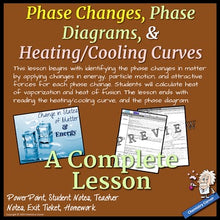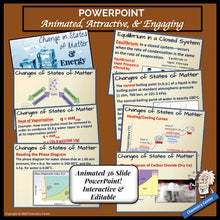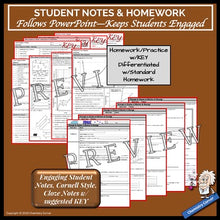In this lesson, students will develop a working concept of what is going on during a phase change related to energy changes, change in particle movement and arrangement, and changes in forces of attraction that affects the particles. Equilibrium during phase changes and energy involvement in the change is emphasized along with equilibrium vapor pressure, and energy. Endothermic and exothermic physical reactions are defined and many practice opportunities in identifying them is available. These concepts, along with the prior work with states of matter: particle arrangement, motion, and forces of attraction, will all come together as we discuss changes of states of matter. Students will calculate heat of vaporization and heat of fusion, be introduced to reading a heating/cooling curve, and interpreting a phase diagram. If you don’t teach calculation of heat of vaporization or heat of fusion, no worries, the lesson has been differentiated to cover that.
NGSS:
NGSS:
HS-PS3 Energy
HS-PS3-2
DCI: PS3.A, PS3.B
Science & Engineering Practices—Developing and Using Models
Cross-Cutting Concepts—Energy & Matter
Lesson Objectives:
-
Discuss the role of vapor pressure in changes of state between a liquid and its gas.
-
Explain forces of attraction and energy changes involved in change of state.
-
Describe the relationship between energy and change of state in terms of endothermic or exothermic processes.
-
Identify the six changes of state, and the energy involvement associated with each change.
-
Calculate the amount of energy absorbed or released in order for a change of state to occur. (Hvap, Hfus)
-
Interpret a heating/cooling curve to identify changes of state, melting and boiling points, changes in energy, and equilibrium.
-
Draw and Interpret a phase diagram to identify melting point and boiling point, and triple point.
-
Explain the phase diagram as a relationship between pressure and temperature.
-
Describe how equilibrium conditions are represented in a phase diagram.
Prior Knowledge:
Knowledge of the states of matter with regards to particle arrangement and movement, and forces of attraction (particulars about bonding is not necessary—if you have not taught that yet).
Lesson Duration: One –two class periods
Included in This Resource:
-
PowerPoint presentation (36 slides), animated and editable
-
Student Guided Notes (Cornell Style Cloze Notes)
-
Suggested Key for Student Notes
-
Teacher Notes with lesson plan and background info
-
Check for Understanding Exit Ticket w/KEY
-
Homework/In Class Practice w/KEY
4 Homework assignments:
Changes and Energy (Honors & Standard)
Reading the Heating/Cooling Curve
Reading the Phase Diagram
Teacher Prep Time: Just print and go!
Note on the PowerPoint: The PowerPoint included in this product is editable. It is also animated, which means that it may appear busy or overlapping in the slide edit mode, but will be awesome in the slide show mode! Please don’t edit the PowerPoint until you have seen it in the slide show mode!
This lesson is appropriate for grades 9-12 chemistry. Not appropriate for Middle School—for middle school see my lesson: Changes in States of Matter: PowerPoint with INB Notes & Lab
This will be a lesson you will want to use year after year!
Chemistry Corner
*************************************************************************************
Check out these other products that you may be interested in:
States of Matter & the Kinetic-Molecular Theory: Gases
States of Matter and the Kinetic Molecular Theory: Liquids
States of Matter and the Kinetic Molecular Theory: Solids
Chemistry Doodle Notes for the Year: A Growing Bundle
High School Chemistry Year Curriculum
*************************************************************************************
Chemistry Corner’s PowerPoints are perfect for the flipped classroom. However, please read the Copyright Terms below before using it as such. Thanks!
LICENSING TERMS: By downloading this product, you own a license for one teacher only for personal use in your classroom. Licenses are non-transferable, meaning they cannot be passed from one teacher to another. No part of this resource is to be shared with colleagues or used by an entire grade level, school, or district without purchasing the proper number of licenses. I you are a coach, principal or district interested in transferable licenses to accommodate yearly staff changes, please contact beth@chemistrycorner.com.
COPYRIGHT TERMS: ©Chemistry Corner. Please note – all material included in this resource belongs to Chemistry Corner. By downloading, you have a license to use the material, but you do not own the material. This resource, or any portion of this resource, may not be uploaded to the internet in any form, including classroom/personal websites or network drives, unless the site is password protected and can only be accessed by students—no other teachers or anyone else on the internet.








